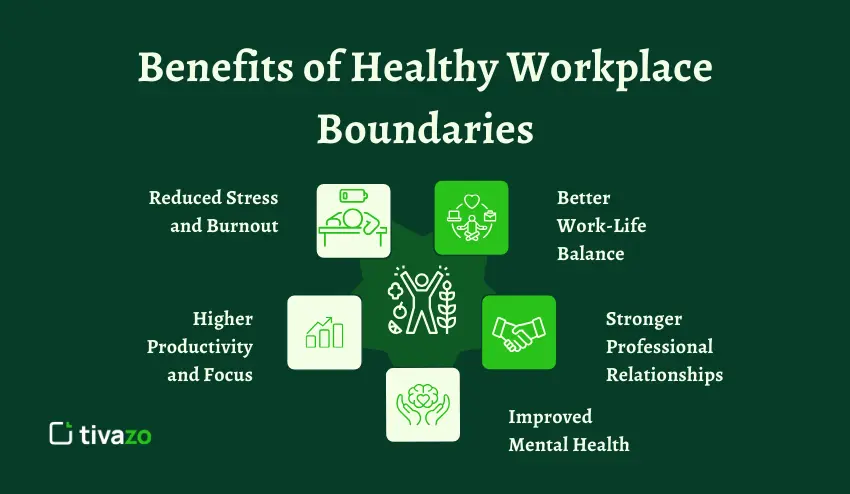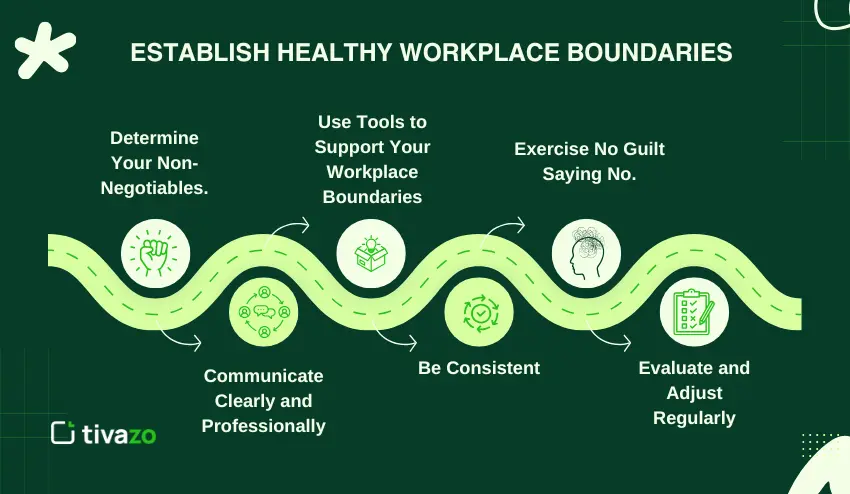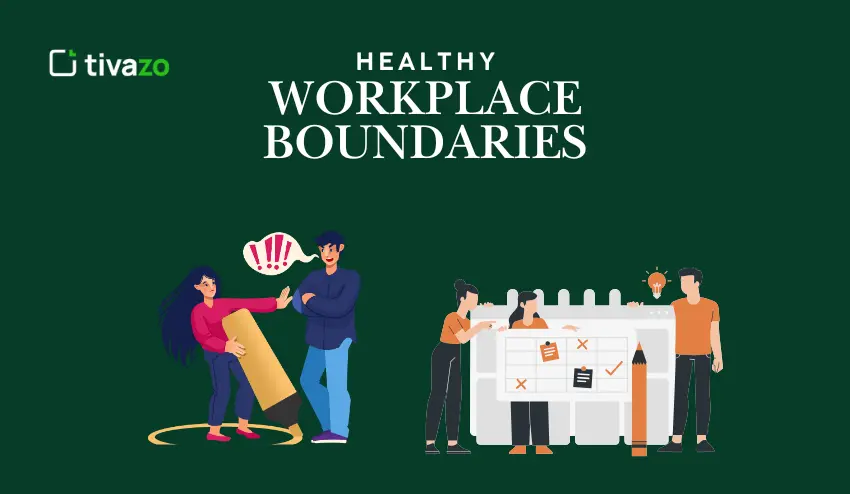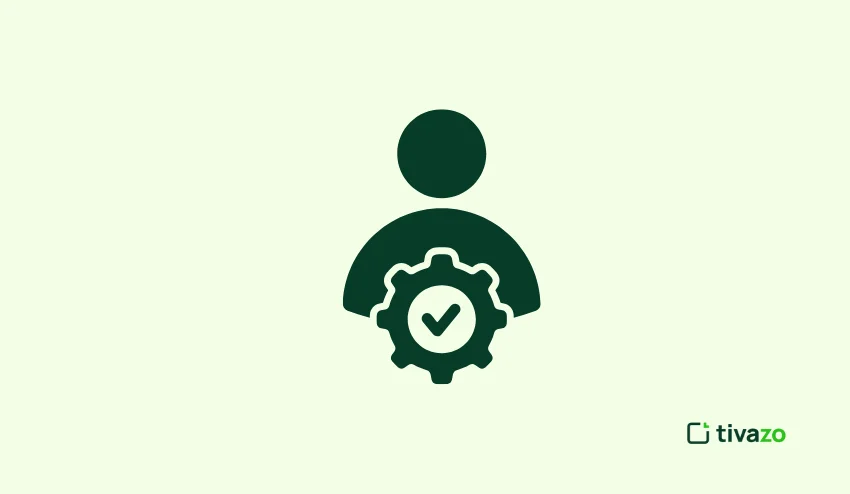Have you ever been tired after a working day not due to the work, but because you could not say no when you had to? This is a challenge to many professionals. They take on additional work, respond to emails in the middle of the night or allow colleagues to distract their concentration time. The outcome is stress, burnout, and resentment.
It is here that workplace boundaries come in. Boundaries do not mean being rude or lazy. They are concerned with saving your time, energy, and mental health to enable you to do your best. The issue is, most people feel guilty when establishing boundaries at the workplace. That guilt can prevent them to protect themselves even in need to do so.
In this guide, I will tell you how to establish healthy workplace boundaries without feeling guilty. You will discover what boundaries are and why guilt manifests, and how to overcome it. I will also provide you with practical steps, script and real work situations. At the end, you will know how to set limits and enhance your well-being and performance.
We should begin by defining what workplace boundaries are and why they are important.
What Are Workplace Boundaries?
A workplace boundary is essentially a distinct boundary you establish to safeguard your time, energy, and mental health. Imagine that it is a kind of invisible line, which shows what is acceptable and what is not in your professional sphere. These limits make your work sustainable, thus you do not burn out and feel like you are being pulled in all directions.
Workplace boundaries can be of various kinds:
- Time boundaries – When your workday starts and when it ends. E.g, leaving at 6 PM and not opening emails till the morning.
- Communication boundaries- It is important to be specific about when and how people can contact you. This may include turning off notifications past working hours or requesting co-workers to check your calendar first before arranging meetings.
- Emotional boundaries – Not letting yourself get sucked into someone else’s stress or getting embroiled in disputes. It is fine to be sympathetic without absorbing the problems of the rest of the world. Helping to reduce mental fatigue.
- Physical boundaries – Owning your own space at work, a quiet desk, or a closed door to an office when you need to be able to concentrate.
- Digital boundaries – Making lines around the use of technology. That could be silencing chat rooms at night or turning off work applications on holidays.
It is easy to get into overcommitment without having clear workplace boundaries. You can say yes to all the requests, reply to the messages late in the night, and lose personal time. In the long run, this trend destroys your productivity and your mind.
Knowing the kinds of boundaries will help you start recognizing which ones you are lacking and where you need the greatest protection. This preconditions the establishment of healthier work patterns.
Why Do People Feel Guilty of Establishing Boundaries?
Guilt can tend to restrain people even when they are aware they require workplace boundaries. This guilt is normally as a result of a combination of individual beliefs, company culture, and fear of failure to satisfy others.
Fear of being regarded as uncooperative is one of the reasons. Most practitioners feel that saying no will cause them to seem lazy or unwilling to contribute. As a matter of fact, overcommitting causes missed deadlines and poor performance. Boundaries do in fact, safeguard your capability to produce good results.
The other is pressure due to company culture. There are still workplaces that celebrate the long hours and the 24/7 access. It is easy to feel guilty when everyone is sending messages at midnight when you are going to bed.
People-pleasing tendencies also result in guilt. A great number of workers desire to be loved by their peers and supervisors. They are afraid that boundaries will make them appear tough yet by saying yes to all things, resentment will be created in the long run.
Lastly, ambiguity of job roles may increase guilt. The absence of a definition of responsibilities makes people feel pressure to do all the tasks that come on their desk. It is not right to set a boundary since the boundaries of the role were not evident in the first place.
It aids in redefining this attitude. Boundaries do not concern the rejection of people or the avoidance of responsibility. They are concerned with saving your time and efforts so that you may be able to show your best selves at work. Actually, healthy workplace boundaries are as helpful to your team as they are to yourself.
Benefits of Healthy Workplace Boundaries
The difference when you establish healthy workplace boundaries is greater than you may imagine. These boundaries not only keep you safe from burnout but also enhance your performance and relationships in workplace.

1. Reduced Stress and Burnout
Without clear limits, work creeps into every part of your life. Such continuous pressure is stressful and can ultimately burnout. Well-defined workplace boundaries provide your mind and body with an opportunity to rest, hence you report back to work refreshed.
2. Higher Productivity and Focus
You make time to do meaningful work when you block distractions and manage interruptions. Limits around communication and workload are there to ensure you concentrate on what is really important rather than being overly spread.
3. Better Work-Life Balance
Life outside of work is important, as well as work. Boundaries guarantee that you get time to spend with your family, hobbies, and rest. This equilibrium leaves you happier, and work does not dominate your personal life. This creates balance between work and life.
4. Stronger Professional Relationships
Boundaries in the workplace make expectations apparent. Your colleagues understand when you are free, how you would like to communicate, and what tasks come under your job. This minimizes misunderstandings and develops respect.
5. Improved Mental Health
Limits provide you with time to feel and guard your health. You are not overworked and always on call and that makes you feel less stressed, more confident and more in charge of your career.
Each of these advantages supports the other. Fewer stresses translate to increased concentration. Increased productivity is enhanced by better concentration. Productivity will assist you in gaining respect and boundaries will be even easier to set. This is why boundaries are not a constraint but a base towards long term success.
What Are Some Good Workplace Boundaries?
Whenever individuals are introduced to the concept of workplace boundaries, they tend to pose the question, What does that actually look like in practice? Boundaries are not merely ideas. They are habits, decisions, and boundaries that you make daily that determine how you will relate with colleagues, supervisors, and your workload.
Here are a few healthy workplace boundaries you can begin to implement:
- Respecting Work Hours
- Failure to respond to emails or calls outside of your working hours.
- Inform your manager and team of your availability.
- Protecting Focus Time
- Scheduling blocks of your calendar to do deep work using time boxing methods.
- Graciously refusing unproductive meetings.
- Communication Boundaries
- Establishing an understanding of how and when you will reply to messages.
- Making status updates or auto-replies when you are away.
- Workload Boundaries
- Saying no to the projects which are not in line with your position or which are beyond your capability.
- Requesting a prioritization in case of several urgent requests being hit simultaneously.
- Emotional Boundaries
- Not being sucked into office gossip or fights that waste energy.
- Don’t absorb the stress of other people and protect your mental space.
- Physical and Digital Boundaries
- Ensuring that your workspace is not interrupted all the time.
- Switching off notifications in the evening or silencing group chats that aren’t urgent.
These are some of the good workplace boundaries that can be established by anyone. They do not turn you hard and unhelpful. Instead, they create clarity. Boundaries demonstrate to your colleagues when and how you can be of best use.
When you consider what boundaries to establish, you should think about the areas in which you are the most exhausted or distracted. Limits will tend to make the most difference there.
Common Workplace Boundary Issues (With Examples)
Although you understand the significance of workplace boundaries, some circumstances may cause you to struggle to uphold them. The first step to dealing with these problems is to identify them.

- After-Hours Communication
Most employees are under pressure to answer emails, calls or messages when not at work. In the absence of a delimiting time, the work may spill over into evenings and weekends. - Interruptions During Focus Time
Your colleagues can visit your desk and keep on sending you messages, which disrupts concentration. Without boundaries around focus time, productivity and mental clarity suffer. - Overcommitting to Tasks
It can make you say yes to all the projects. Doing more work than you should or are capable of results in errors and burnout. Establishing work limits will make sure that you produce high results. - Managers Who Do Not Respect Time Off.
Other leaders do not pay attention to vacation days, breaks, or flexible working hours unintentionally. The absence of strict boundaries will make the employees feel compelled to be available at all times. - Blurred Lines in Remote Work
It may be difficult to separate work and personal time when working at home. The continuous notifications and absence of a specific workspace usually necessity working more hours than required.
You can begin developing effective strategies to conserve your time and energy by determining the areas in which your boundaries are being tested at the workplace. Being aware of these typical pitfalls will also equip you to discuss your limits with colleagues or managers.
How to establish healthy workplace boundaries (step-by-step guide)
Boundaries at work are not about saying no. It is about saving your time, energy, and mental health and remaining professional and collaborative. The following is a realistic step-by-step procedure:

1. Determine Your Non-Negotiables.
Begin by knowing your boundaries. When do you need to work focus during the day? What are the projects you are able to handle simultaneously? Being aware of what you are not going to negotiate establishes the boundaries.
2. Communicate Clearly and Professionally
Be aware of your limits, then tell your team and your manager. Use polite, assertive language. For example:
“I am free to hold meetings between 10 AM and 4 PM.”
“During working days, I will reply to e-mails within 24 hours.”
3. Use Tools to Support Your Workplace Boundaries
Leverage calendars, status indicators, time tracking apps, and auto-replies. Deep work or do not disturb calendar blocks help avoid disruptions and remind your boundaries without having to be reminded every minute.
4. Be Consistent
Stability supports your limits. When you answer messages after hours sometimes and not sometimes, then you confuse the other people and undermine your boundaries. Be persistent on a daily basis to develop respect of boundaries.
5. Exercise No Guilt Saying No.
It does not need to be confrontational to decline tasks. Here are examples you can use:
“I would be glad to assist, but I am at the limit just now. Can we look into this next week?”
“I can make this assumption, but we would need to shift priorities on my current projects.”
“I need to focus on the present to do quality work. I cannot assist in this today.”
6. Evaluate and Adjust Regularly
Workplace Boundaries may need to change with a changing job or load. Periodically revise them and amend where necessary so that there is a balance and effectiveness.
These steps will make setting the limits in the workplace a structured, non-stressful process instead of a stressful negotiation. Clear boundaries assist in protecting yourself, improving your performance and being respected by other employees.
Conquering the Guilt in Boundary-Setting.
One of the greatest challenges to setting workplace boundaries is feeling guilty. Most workers fear that refusing to say no or saying no and imposing boundaries will offend other workers, seem indolent, or hurt relationships. The positive thing is that guilt is controllable once the right attitude and techniques are adopted.
- Reframe Guilt as Self-Respect
Rather than looking at boundaries as selfish, consider them as professional self-care. Conserving time and energy will make sure that you can provide high-quality work and be able to support your team. Boundaries are an instrument of long-term achievement, not a weakness. - Focus on the Win-Win
Good boundaries are healthy and are good for you and your organization. Setting limits keeps you productive, avoids burnout, and sets an example of responsible behavior to your colleagues. This school of thought makes guilt a professional asset. - Start Small and Build Confidence
You shouldn’t go redesigning your boundaries simultaneously. Start with a single area, like restricting after-hours email or focus time blocking. Any boundary that you successfully implement creates confidence and minimizes guilt in the long run. - Use Mental Exercises
Ask yourself questions such as: “How would I handle this situation, had I not felt guilty? or “Would my team not work better under this limit? Through these exercises, you learn to view boundaries as a normal, necessary thing and not something to feel bad about. - Celebrate Small Wins
Congratulate yourself every time you effectively impose a boundary. Positive reinforcement reinforces the habit and lowers guilt. With time, setting boundaries in the workplace will become comfortable and professional with practice.
This way of approaching the emotional aspect of setting boundaries will enable you to establish boundaries with confidence and no inner struggle. When you feel that you have a limit to which you can perform, be well and develop a career, guilt is reduced.
How Managers Can Set Workplace Boundaries
It is not the employees only who have a role in ensuring that the workplace boundaries are healthy. Managers are instrumental in establishing a culture of boundaries being observed and enforced. Leaders supporting and modeling limits promote a culture of balance and productivity.
- Model Healthy Workplace Boundaries
Managers set the tone. Do not send emails at night and do not expect the employees to be accessible at all times. Showing respect to your boundaries will indicate to the team that it is okay to do so as well. - Set Clear Expectations
Be clear on the hours of work, availability and response time. Employees will be able to impose their own limits without the fear of being judged when they understand what is expected. - Promote Open Communication.
Provide a secure environment in which employees are able to talk about workload, stress or boundary issues. Frequent check-ins and one-on-one meetings enable managers to recognize the problem of boundaries and discuss them beforehand. - Reward Outcomes, Not Overwork
Concentrate on the outcomes and not the time spent on the job. When employees know their performance is determined by quality, rather than by being always available, they will tend to be more likely to draw boundaries. - Protect Time Off
Respect vacation days, breaks, and personal time. Do not bother employees during such times unless the situation is really urgent. Understand that sleep is a key to long-term performance.
Managers enhance the well-being of employees, as well as, increase efficiency and morale in the team by upholding workplace boundaries. Respectful culture fosters a more involved, productive, and loyal workforce.
Maintaining Workplace Boundaries Over the Long Run.
It is not enough to establish Workplace boundaries, but to keep them up.
- Stay Firm, Expect Pushback
Not all colleagues will be willing at the beginning. Discuss how your boundaries assist you in being productive and producing quality work. - Review and Adjust
Review your limits as tasks evolve to make them realistic. - Build Habits
Include boundaries in routines such as planned breaks, focus blocks and offline hours. They are natural because of consistency. - Celebrate Wins
Acknowledge each successful enforcement. It enhances self-esteem and mollifies conscience. - Share and Educate
The more your teammates know about your limits, the more likely they are to respect them.
The maintenance of workplace boundaries in the long run is a way of maintaining respect, concentration, and well-being without guilt.
Conclusion
Establishing good workplace boundaries is not a matter of being tough or uncooperative. It is about safeguarding your time, energy and brain health to be able to do the best you can. Boundaries lower stress, enhance concentration, and enhance respect amongst colleagues.
Begin small, speak straight and be uniform. With time, boundaries will be easy to implement with no feeling of guilt. Keep in mind that self-protection is in the end good to your team and to your career. Start by determining one boundary that you can set today.




